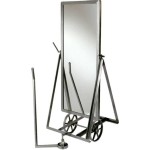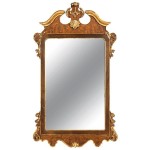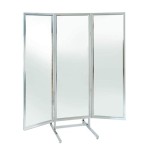Victorian Wall Mirrors: A Glimpse into a Bygone Era
Victorian wall mirrors, with their intricately carved frames and shimmering glass, are more than just reflective surfaces. They are time capsules, capturing the aesthetic values and societal norms of a bygone era. These mirrors, produced during the Victorian era (1837-1901), served both practical and decorative purposes, reflecting not only the physical world but also the opulent tastes and social aspirations of the time.
The Victorian era witnessed a significant shift in interior design, moving away from the austere and functional aesthetic of the preceding Georgian period. This shift embraced a more ornate and decorative style, and mirrors played a crucial role in enhancing this aesthetic. Victorian mirrors, often adorned with intricate carvings, gilded frames, and ornate embellishments, were designed to create a sense of grandeur and sophistication in homes. Their reflective surfaces not only amplified the available light but also multiplied the visual impact of the room's decor.
Materials and Design
While the materials used in Victorian mirrors varied depending on the intended use and the economic status of the owner, some common elements appear across different types. The frames were often crafted from wood, which was then adorned with intricate carvings, painted with vibrant colors, or gilded with gold or silver leaf. The glass itself was generally of high quality, often with a slight bevel to enhance its reflective properties.
The design motifs used in Victorian wall mirrors ranged from classical Greek and Roman themes to more contemporary floral and botanical patterns. Many mirrors featured elaborate designs incorporating motifs like acanthus leaves, scrolls, and cherubs, reflecting the era's fascination with classical aesthetics.
Types of Victorian Wall Mirrors
Victorian wall mirrors came in numerous styles, each with its own unique characteristics:
1. Overmantel Mirrors
These large, ornate mirrors were often placed above the fireplace mantelpiece, serving as a focal point in the room. Overmantel mirrors frequently incorporated intricate carvings, elaborate frames, and sometimes even decorative shelves or brackets. Their grandeur added a touch of luxury to the room and offered a focal point for decorative objects.
2. Vanity Mirrors
Vanity mirrors, designed for use in dressing rooms or bedrooms, were smaller and often featured more delicate designs. They were often framed in intricate carvings, gilded with gold or silver, and sometimes adorned with feminine motifs like flowers or birds. Vanity mirrors offered a practical tool for personal grooming and a decorative element for the bedroom.
3. Console Mirrors
Console mirrors were typically placed over a console table in a hallway or entryway. They were often rectangular in shape and featured ornate frames, often incorporating classical motifs like acanthus leaves or scrolls. Console mirrors served both practical and decorative purposes: reflecting light into the hallway and adding a touch of elegance to the entrance.
4. Pier Mirrors
Pier mirrors were typically placed on the walls of a room, flanking windows or doors. These large, rectangular mirrors often featured simple frames, sometimes adorned with delicate carvings or painted with subtle colors. They served to expand the visual space of the room, reflecting light and creating a sense of depth.
Significance in Victorian Culture
Victorian wall mirrors held social and cultural significance beyond their practical and decorative functions. They played a role in fostering a sense of status and identity, reflecting the homeowner's wealth, taste, and social standing. The presence of an elaborate overmantel mirror in the drawing room could signify a family's affluence and social prominence.
Beyond their social implications, Victorian wall mirrors also served as a reminder of the era's emphasis on appearances and social etiquette. The mirrored surfaces encouraged introspection and self-awareness, reinforcing the importance of presenting oneself appropriately in society.
Today, Victorian wall mirrors remain highly sought-after by collectors and enthusiasts. Their intricate design, historical significance, and timeless elegance make them valuable pieces that can add a touch of vintage charm to any contemporary home. Whether displayed as stand-alone pieces or incorporated into a larger design scheme, Victorian wall mirrors offer a glimpse into a bygone era, reminding us of the enduring beauty and craftsmanship of the past.

Vintage Turner Ornate Victorian Wall Mirror

Vtg Victorian Round Wall Mirror Cast Iron Frame Gold Filigree 9 5 X

25x 16 Oval Vintage Decorative Victorian Wall Mirror White Wooden Frame Antique Princess Decor For Bedroom Playroom Dressers Living Room

Victorian Oval Wall Mirror 1880 For At Pamono

Antique Large Ornate Victorian Metal Framed Wall Mirror Chairish

Wood Carved Acanthus Wall Mirror With Arched Top And Distressing Cream Olivia May Target

Victorian Pollard Oak Wall Mirror 1880s For At Pamono

Victorian Style Wall Mirror Antique Farmhouse

Antique Large Victorian Oak Overmantle Wall Mirror Antiques To Buy

Antique Victorian Wall Mirror Chairish








